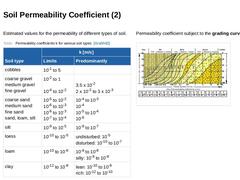
|
Estimated values for the permeability of different types of soil. (Table: Permeability coefficients k for various soil types) Permeability coefficient subject to the grading curves. (Image: Permeability coefficient with reference of the particle size distribution curve [LWA89] [FI-Herreb]) |
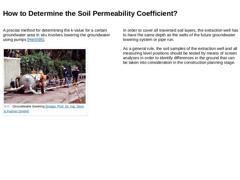
|
A precise method for determining the k-value for a certain groundwater area in situ involves lowering the groundwater using pumps [Herth95]. (Image: Groundwater lowering) In order to cover all traversed soil layers, the extraction well has to have the same depth as the wells of the future groundwater lowering system or pipe run. As a general rule, the soil samples of the extraction well and all measuring level positions should be tested by means of … |
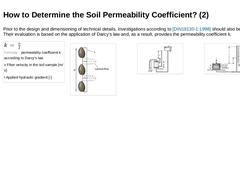
|
Prior to the design and dimensioning of technical details, investigations according to [DIN18130-1:1998] should also be included. Their evaluation is based on the application of Darcy‘s law and, as a result, provides the permeability coefficient k. (Formula: Permeability coefficient k according to Darcy‘s law) (Image: Filter velocity v = Q (flow) / A (cross section)) (Image: Examples of permeability tests [Soos96] - Test arrangement with constant hydraulic … |
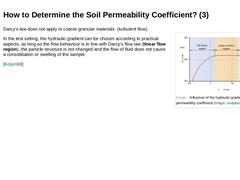
|
(Image: Influence of the hydraulic gradient onto the permeability coefficient) Darcy‘s law does not apply to coarse granular materials (turbulent flow). In the test setting, the hydraulic gradient can be chosen according to practical aspects, as long as the flow behaviour is in line with Darcy‘s flow law (linear flow region), the particle structure is not changed and the flow of fluid does not cause a consolidation or swelling of the sample. [Kolym98] |
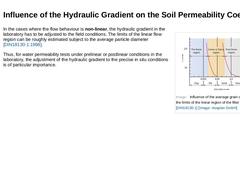
|
(Image: Influence of the average grain diameter d onto the limits of the linear region of the filter flow law) In the cases where the flow behaviour is non-linear, the hydraulic gradient in the laboratory has to be adjusted to the field conditions. The limits of the linear flow region can be roughly estimated subject to the average particle diameter [DIN18130-1:1998]. Thus, for water permeability tests under prelinear or postlinear conditions in the … |
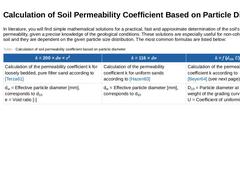
|
In literature, you will find simple mathematical solutions for a practical, fast and approximate determination of the soil's water permeability, given a precise knowledge of the geological conditions. These solutions are especially useful for non-cohesive types of soil and they are dependent on the given particle size distribution. The most common formulas are listed below: (Table: Calculation of soil permeability coefficient based on particle diameter) |
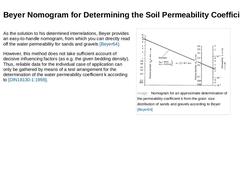
|
As the solution to his determined interrelations, Beyer provides an easy-to-handle nomogram, from which you can directly read off the water permeability for sands and gravels [Beyer64]. However, this method does not take sufficient account of decisive influencing factors (as e.g. the given bedding density). Thus, reliable data for the individual case of application can only be gathered by means of a test arrangement for the determination of the water … |
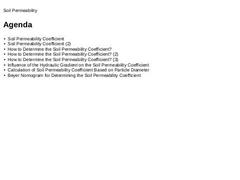
|
|

|
|

|
Congratulations! You have successfully finished this lesson. Next you will have the opportunity to review the newly acquired knowledge with an interactive questionnaire. You can of course still navigate back to any point in the lessons if you wish to review a specific point or subject. Stay curious! |
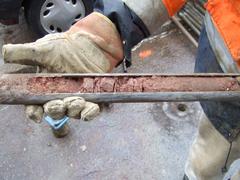
|
The construction of sewers is often carried out using the open construction method. Depending on the design, this results in pipe-soil systems with different external loads on the sewer. To understand these relationships, the soil mechanical and hydrogeological principles for characterizing the subsoil are explained. After completing this module, you will have a sound knowledge of how: - to differentiate between soil types;
- to identify the influences of grain shape and grain size distribution on the practical construction properties of the subsoil and
- to name the different appearances of water in the subsoil;
- to determine the water permeability of the soil for a constructional assessment of the soil.
|

|
The excavation of utility trenches and their safe construction belong to the field of geotechnology. In geotechnology, the soil (or rock) forms the subsoil and serves as construction material. It can also act as a load or form the load-bearing and stabilising material. In other words, geotechnology deals with the requirements that have to be given in order to use the soil (or rock) in the form of stable and functional civil engineering structures [… |

|
To the field of Geotechnology belong, amongst others, the following scientific disciplines: -
Geological engineering: Science that incorporates the application and evalutation of geological know-how and consolidated findings when dealing with construction works.
-
Soil and rock mechanics (geomechanics): Science with the objectives…
-
To investigate the subsoil,
-
To describe and classify the soil,
-
To determine the strength and deformation behaviour of …
|
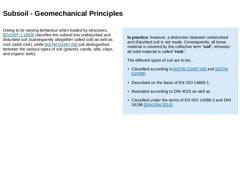
|
Owing to its varying behaviour when loaded by structures, [EN1997-1:2009] classifies the subsoil into undisturbed and disturbed soil (subsequently altogether called soil) as well as rock (solid rock), while [[ASTM D2487-06]] just distinguishes between the various types of soil (gravels, sands, silts, clays, and organic soils). In practice, however, a distinction between undisturbed and disturbed soil is not made. Consequently, all loose material is … |

|
The following will look at soil characteristics in greater detail. |
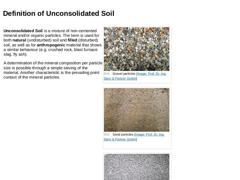
|
|
Unconsolidated Soil is a mixture of non-cemented mineral and/or organic particles. The term is used for both natural (undisturbed) soil and filled (disturbed) soil, as well as for anthropogenic material that shows a similar behaviour (e.g. crushed rock, blast furnace slag, fly ash). A determination of the mineral composition per particle size is possible through a simple sieving of the material. Another characteristic is the prevailing point contact … |
|
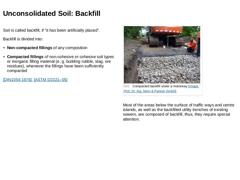
|
Soil is called backfill, if “it has been artificially placed”. Backfill is divided into: -
Non-compacted fillings of any composition
-
Compacted fillings of non-cohesive or cohesive soil types or inorganic filling material (e. g. building rubble, slag, ore residues), whenever the fillings have been sufficiently compacted
[DIN1054:1976], [[ASTM D2321–05]] (Image: Compacted backfill under a motorway) Most of the areas below the surface of traffic ways and … |
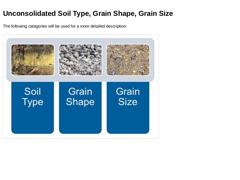
|
The following categories will be used for a more detailed description: (Image: Unconsolidated soil categories) |

|
|

|
The main types of soil are: -
Non-cohesive soil
-
Cohesive soil
-
Organic (organogenic) soil
-
Vulcanic soil
|
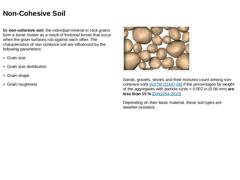
|
By non-cohesive soil, the individual mineral or rock grains form a loose cluster as a result of frictional forces that occur when the grain surfaces rub against each other. The characteristics of non-cohesive soil are influenced by the following parameters: -
Grain size
-
Grain size distribution
-
Grain shape
-
Grain roughness
(Image: Non-cohesive soil particles, held loosely together through the grain surface friction) Sands, gravels, stones and their … |

|
In the case of cohesive soil, the particles cling together as a result of electrostatic surface forces, and thus form a bonded and mouldable mass. Its characteristics (strength) is essentially influenced by the following parameters: -
Water content
-
Particle size
-
Clay mineral content
This type of soil is sensitive to weather conditions. It includes clays, clayey silts (e.g. sandy clay, sandy silt, loam, marl) as well as their mixtures with non-cohesive … |
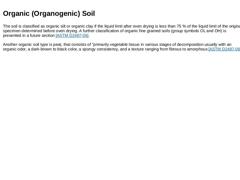
|
The soil is classified as organic silt or organic clay if the liquid limit after oven drying is less than 75 % of the liquid limit of the original specimen determined before oven drying. A further classification of organic fine grained soils (group symbols OL and OH) is presented in a future section [[ASTM D2487-06]]. Another organic soil type is peat, that consists of "primarily vegetable tissue in various stages of decomposition usually with an … |
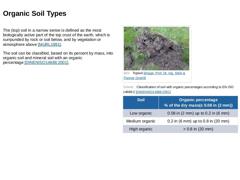
|
The (top) soil in a narrow sense is defined as the most biologically active part of the top crust of the earth, which is surrpunded by rock or soil below, and by vegetation or atmosphere above [MURL1991]. The soil can be classified, based on its percent by mass, into organic soil and mineral soil with an organic percentage [DINENISO14688:2001]. (Image: Topsoil) (Table: Classification of soil with organic percentages according to EN ISO 14688-2) |
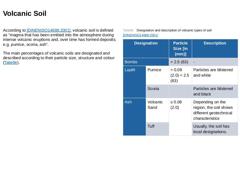
|
According to [DINENISO14688:2001], volcanic soil is defined as “magma that has been emitted into the atmosphere during intense volcanic eruptions and, over time has formed deposits; e.g. pumice, scoria, ash”. The main percentages of volcanic soils are designated and described according to their particle size, structure and colour (Table). (Table: Designation and description of volcanic types of soil [ENISO14688]) |